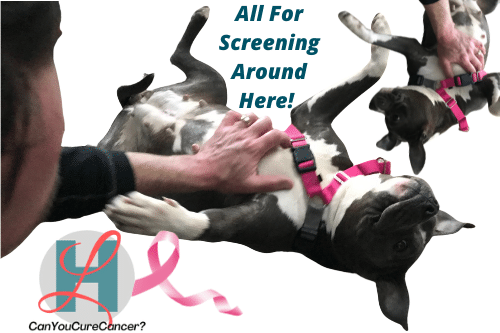
Let’s Get Screening!
Breast cancer awareness is all about education! Why are we so embarrassed to talk about breasts! Clearly Stitch has no shame in his game!
Who should be screened?
Women- Of Course!
Dogs- You bet! I mean look how many nipples have potential problems!
Men- YES!!
Breast cancer awareness men?
Um YES! Do women get testicular cancer? No. Why? Because we don’t have testicles, we have ovaries. So we get ovarian cancer. Men, however, do have similar breast tissue to women. We all have nipples. Nipples are formed in embryos before our bodies are even genetically developing as male, or female.
Although male breasts have no glandular tissue and undeveloped milk ducts, they still need to be checked for lumps, bumps and abnormalities. Yes men can still get breast cancer. Breast tissue is breast tissue and cell abnormality (cancer cells) can still grow and spread.
I mean just look at Bob Carey! Traveling the world in his pink tutu, baring his teats for all to see to raise awareness and to raise money to support breast cancer patients- both with financial and emotional burden. I mean we’re talking about breast cancer awareness for men here, and here’s a man spreading breast cancer awareness- love it!
I will say, even the pink tutu, however, has its implications. Please don’t read this wrong, I LOVE the tutu project and support and love their efforts! Actually they’re one of my favorites. A pink skirt does, however, bring to mind support of a women’s disease. I know women, men, non-binary alike, all rock a pink skirt from time to time, but I think this goes back further in history.
How did the ribbon for breast cancer become pink? Was it chosen purposely with breast cancer, as a women’s disease, in mind?
So the original breast cancer ribbon…. Not Pink! Who knew?! According to Square Cow Movers, it was light peach and was initiated by a Charlotte Haley, an activist in 1991. It was the Susan G. Komen Breast Cancer Foundation who started a pink movement in regards to breast cancer; handing out pink visors to women in a Race for the Cure.
It later became popular, when in 1992 Evelyn Lauder (of Estee Lauder), a breast cancer survivor herself, added the pink colored ribbon in the Breast Cancer Awareness Month Issue of Self magazine; when she teamed up with the then editor of Self Magazine, Alexandra Penney, and handed them out at Estee Lauder counters everywhere.
What I do know is that when someone has a ‘gender reveal’ party, the color they blast upon realizing the child is a girl, is PINK! The feminine color association was in fact a consideration of the pink ribbon origin and was not lost on these women. Pastel pink also is thought to be health giving, amongst other things. I still stand by breast cancer awareness men, pets, and women! We all need healthy chests.
Breast cancer is not a woman’s disease. Breast cancer awareness men. Breast cancer awareness pups. Breast cancer awareness women! Breast. Cancer. Awareness. Period.

The American Cancer Society put out a guideline for breast cancer screening for average risk women in October, 2015. The changes you’ll note are that the recommendations for starting annual screening with mammograms was moved to age 45 from 40. Ages 40-44 can still start if they want (Always tough because screening saves lives, but exposure to radiation is also a consideration- more on this in future blogs).
You’ll also notice that screening every 2 years starts at 55 (but annual screening can continue if you choose).
The American Cancer Society also states that a clinical breast exam, or a self-breast exam, are no longer recommended options for screening methods for women in the U.S., of any age- again, for average risk individuals. This one seems a bit contradictory to me, but a self exam at home to check for lumps, in between mammograms, still seems like a step worth taking. Ask your doctor!
It’s not in my nature to just let information like this sit with me and not follow up with some further investigation. Basically, what happened was that research was conducted that showed no benefit of individuals (via self breast exams), or a health professional (via a clinical breast exam) performing regular, physical breast exams.
They went on to say that there is very little evidence that those screenings help find breast cancer early, when women are also getting screening mammograms. I for one, still see a benefit. I have personal experience with patients who found their own lumps first. Time matters with cancer.
Research is a funny thing, because so many factors come into play. Pay attention to details. They say:
“little evidence”
American Cancer Society
They also went on to say in bold that women need to be familiar with how their breasts typically look and feel, so you can report changes to your health care provider right away. So they know how important this early detection and observation is. Look at their link for more details, but even they advise to continue looking.
Check out this link for details of the screening recommendations for women at average risk of breast cancer. Also the phrase average risk, is defined in the information I linked.
Let’s face it, screenings are critical to early detection. Waiting until symptoms appear can hurt your prognosis, so early detection is key.
Get Your Teats Checked Folks!
Later this month I’ll be giving away a major tip for breast cancer awareness that is typically reserved for my paid course!! Subscribe below so you don’t miss it (and it comes with my free checklist for doctor’s visits)! If you haven’t yet, check out my other blogs!
Later fellow fighters!

